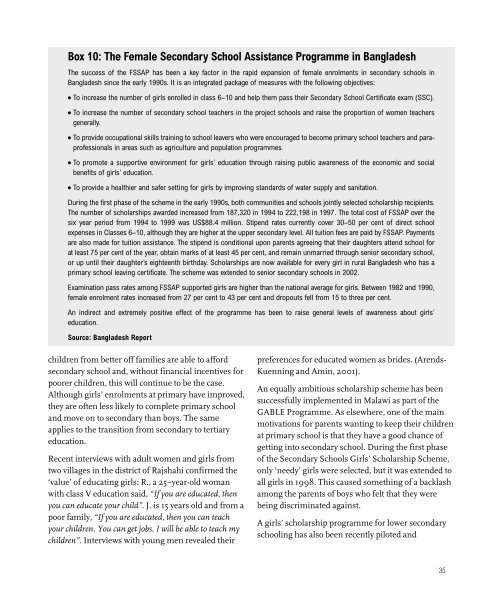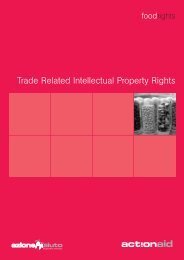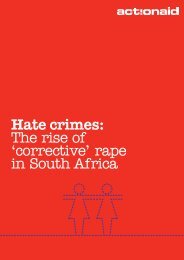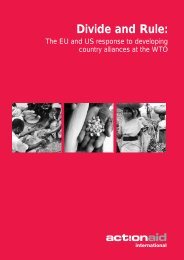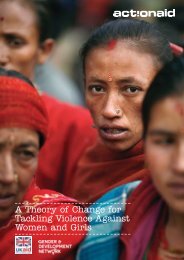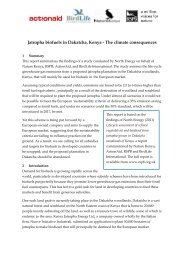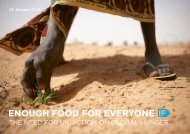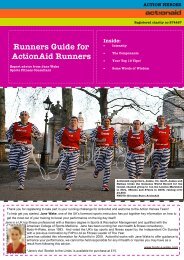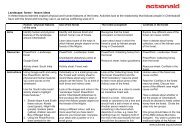A fair chance - United Nations Girls' Education Initiative
A fair chance - United Nations Girls' Education Initiative
A fair chance - United Nations Girls' Education Initiative
Create successful ePaper yourself
Turn your PDF publications into a flip-book with our unique Google optimized e-Paper software.
Box 10: The Female Secondary School Assistance Programme in BangladeshThe success of the FSSAP has been a key factor in the rapid expansion of female enrolments in secondary schools inBangladesh since the early 1990s. It is an integrated package of measures with the following objectives:● To increase the number of girls enrolled in class 6–10 and help them pass their Secondary School Certificate exam (SSC).● To increase the number of secondary school teachers in the project schools and raise the proportion of women teachersgenerally.● To provide occupational skills training to school leavers who were encouraged to become primary school teachers and paraprofessionalsin areas such as agriculture and population programmes.● To promote a supportive environment for girls’ education through raising public awareness of the economic and socialbenefits of girls’ education.● To provide a healthier and safer setting for girls by improving standards of water supply and sanitation.During the first phase of the scheme in the early 1990s, both communities and schools jointly selected scholarship recipients.The number of scholarships awarded increased from 187,320 in 1994 to 222,198 in 1997. The total cost of FSSAP over thesix year period from 1994 to 1999 was US$88.4 million. Stipend rates currently cover 30–50 per cent of direct schoolexpenses in Classes 6–10, although they are higher at the upper secondary level. All tuition fees are paid by FSSAP. Paymentsare also made for tuition assistance. The stipend is conditional upon parents agreeing that their daughters attend school forat least 75 per cent of the year, obtain marks of at least 45 per cent, and remain unmarried through senior secondary school,or up until their daughter’s eighteenth birthday. Scholarships are now available for every girl in rural Bangladesh who has aprimary school leaving certificate. The scheme was extended to senior secondary schools in 2002.Examination pass rates among FSSAP supported girls are higher than the national average for girls. Between 1982 and 1990,female enrolment rates increased from 27 per cent to 43 per cent and dropouts fell from 15 to three per cent.An indirect and extremely positive effect of the programme has been to raise general levels of awareness about girls’education.Source: Bangladesh Reportchildren from better off families are able to affordsecondary school and, without financial incentives forpoorer children, this will continue to be the case.Although girls’ enrolments at primary have improved,they are often less likely to complete primary schooland move on to secondary than boys. The sameapplies to the transition from secondary to tertiaryeducation.Recent interviews with adult women and girls fromtwo villages in the district of Rajshahi confirmed the‘value’ of educating girls: R., a 25–year-old womanwith class V education said, “If you are educated, thenyou can educate your child”. J. is 15 years old and from apoor family, “If you are educated, then you can teachyour children. You can get jobs. I will be able to teach mychildren”. Interviews with young men revealed theirpreferences for educated women as brides. (Arends-Kuenning and Amin, 2001).An equally ambitious scholarship scheme has beensuccessfully implemented in Malawi as part of theGABLE Programme. As elsewhere, one of the mainmotivations for parents wanting to keep their childrenat primary school is that they have a good <strong>chance</strong> ofgetting into secondary school. During the first phaseof the Secondary Schools Girls’ Scholarship Scheme,only ‘needy’ girls were selected, but it was extended toall girls in 1998. This caused something of a backlashamong the parents of boys who felt that they werebeing discriminated against.A girls’ scholarship programme for lower secondaryschooling has also been recently piloted and35


